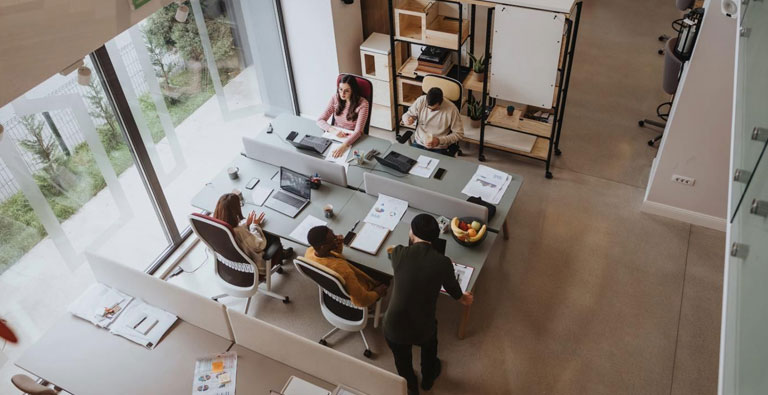The business world has changed enormously in recent years. New ways of organizing work have emerged, such as project-based working, telecommuting… and new, more flexible types of workspace. This is where coworking spaces and other operated offices come in.
Coworking spaces have become essential environments for many professionals. Creating a dynamic and collaborative atmosphere, these work environments are constantly being renewed to offer spaces of well-being, calm and real collaborative and inspiring bubbles. Here are a few tips tested and approved by the workin.space team to cultivate a harmonious balance in your coworking space. Follow the guide.
1 – Ensure physical comfort
The layout of yourcoworking space is essential to ensure physical comfort. Ergonomic seating, height-adjustable desks to avoid muscular pain, but also lime and natural lighting which will tend to reduce eyestrain. The EN 12464-1 standard provides some information on the minimum requirements in this area, depending on the situation. Never forget that the quality of working conditions is the No. 1 criterion to be respected. At workin.space, we have a slight preference for the sit-stand desk, which has rapidly become the centerpiece of our layout, and which we use for most of our informal meetings.
You should also take into account the preventive and hygienic measures applicable in the workplace.
2 – Enhance relaxation areas
Users need to be able to balance their working time between activity and rest. To this end, the inrs offers several recommendations on the organization of “flash” or micro-nap phases. These include
- do not exceed a 15-20 minute nap in your workspace
- plan your micro-naps
- provide an alarm clock
It then becomes necessary to enhance quiet spaces, lined with green plants, softer lighting and comfortable seating. There are even cocoons that guarantee silence or soft music, not forgetting to set an alarm clock. It’s also possible to set up board game areas to free your brain from professional constraints for a moment.
3 – Balancing work and personal life
Coworking spaces can mean long working hours. It’s important to remind users of the reasonable limits to be respected. For example, by reorganizing working hours, encouraging breaks, and setting up a real digital disconnect outside office hours. At workin.space, we like to have aperitifs with our colleagues.
It’s also important to maintain a healthy lifestyle outside the office, with recuperative nights and a balanced diet.
4 – Organize wellness events
Since stress is a worker’s number 1 enemy, it can be a good idea to offer workshops designed to improve your state of mind. Yoga, meditation and gentle gymnastics are all activities recognized for their benefits to the body and mind. Supervised by professionals, users can plan their “own time” during breaks, for example. Here are 9 of the most popular teambuilding activities in coworking spaces.
5 – Encouraging collaboration and communication
It’s important not to feel isolated in a coworking space. Particularly as the norm today is a return to closed offices. That’s why it’s a good idea to set up chat rooms, online forums and social events to encourage networking and sharing.
Cohesion within a group creates a convivial atmosphere, and helps you to develop your network.
6 – Keep your business impeccably clean
In a post-covid world, hygiene is a central concern. A clean L’Espace encourages users to keep it that way. It is therefore essential to ensure that the coworking space and sanitary facilities are kept clean, but also to give users recommendations on how to keep their workspace as clean as they found it when they arrived.
Many laws encourage waste sorting and reduction, and it would be beneficial for everyone to be supported in these civic gestures, which should not become a constraint.
7 – Coordinating users
It’s by consulting the members of your coworking space that you’ll learn more about their needs and the different balancing acts required. Avoid dangerous “idea boxes”, or unilateral decisions, and focus instead on informal discussions on a case-by-case basis.
By applying these few tips, and adapting them to each situation, it is possible to create a space conducive to productivity and creativity, in a convivial setting that respects the well-being of its users.






